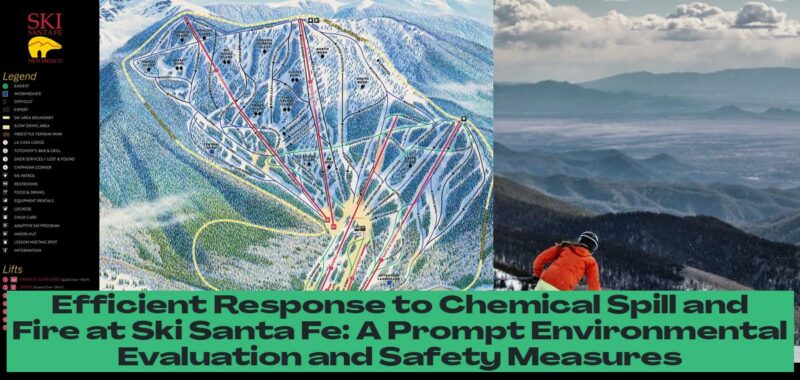A Chemical Spill and Fire at Ski Santa Fe: A Quick Response and an Environmental Assessment
On a Wednesday in July, a routine delivery at Ski Santa Fe took a sudden turn when a truck carrying hydrogen peroxide experienced a spill and caught fire. The Santa Fe National Forest (SFNF) was immediately notified by the ski resort, and they swiftly deployed fire resources along with the City of Santa Fe Fire Department to contain the blaze. The incident prompted a rapid response from a Hazmat team, dispatched by the truck company, and the New Mexico Environment Department (NMED) was alerted to monitor the situation. Fortunately, the spill and fire were contained swiftly, preventing any major escalation.
The incident, while alarming, highlighted the importance of swift response and coordinated efforts in dealing with potentially hazardous situations. The SFNF fire resources, the City of Santa Fe Fire Department, and the Hazmat team worked in unison to bring the incident under control. This demonstrates the crucial role of collaboration and preparedness in mitigating the impact of chemical spills and fires.
The prompt response and containment of the fire at Ski Santa Fe were commendable. However, the incident served as a reminder of the potential dangers posed by hazardous materials. The SFNF and NMED are now conducting a thorough assessment of the affected area, including soil sampling and analysis to determine the extent of the chemical contamination. This comprehensive evaluation is crucial to ensure that the environment is safe and that any potential long-term effects are addressed effectively.
The incident at Ski Santa Fe underscores the importance of robust safety protocols and emergency response procedures for handling hazardous materials. This includes proper training for personnel involved in the transportation and handling of such substances, stringent safety measures during loading and unloading, and well-defined emergency plans to address potential spills and accidents.
- Swift response and collaboration are key in containing chemical spills and fires, as demonstrated by the coordinated efforts of SFNF, City of Santa Fe Fire Department, Hazmat team, and NMED at Ski Santa Fe.
- Thorough environmental assessment post-incident is crucial to determine the extent of contamination and address any potential long-term effects, highlighting the importance of environmental protection measures.
- Robust safety protocols, proper training, and emergency response procedures are essential for handling hazardous materials to prevent incidents like the chemical spill and fire at Ski Santa Fe.
- The incident emphasizes the need for public awareness about the risks associated with hazardous materials and the importance of stringent safety measures to protect both the environment and human health.
The Importance of Environmental Protection and Public Awareness
The incident at Ski Santa Fe serves as a stark reminder of the importance of environmental protection and public awareness regarding hazardous materials. The release of hydrogen peroxide, even on a smaller scale, poses risks to both the environment and human health. This is why the NMED’s involvement in the situation is essential. They will play a crucial role in assessing the extent of the contamination, ensuring the safety of the soil and water resources, and implementing any necessary remediation measures.
Public awareness regarding chemical spills and their potential impacts is crucial. Individuals should be informed about the risks associated with hazardous materials and the importance of reporting any suspected spills or accidents to the appropriate authorities. Timely reporting can enable prompt response and containment, minimizing potential damage to the environment and public health.
The incident at Ski Santa Fe highlights the need for ongoing efforts to educate communities about the dangers of hazardous materials and the importance of environmental protection. This includes promoting responsible handling practices, raising awareness about the potential consequences of spills and accidents, and encouraging proactive measures to minimize risks and mitigate potential damage.
The incident at Ski Santa Fe is a reminder that even seemingly minor accidents can have significant consequences. The swift and coordinated response of the SFNF, the City of Santa Fe Fire Department, and the Hazmat team prevented a larger incident. However, the situation underscores the need for continued vigilance, robust safety protocols, and effective environmental protection measures to address the potential risks posed by hazardous materials. The ongoing assessment and remediation efforts by the NMED are a testament to the commitment to ensuring the safety and health of the environment and the community.
The Importance of Environmental Regulations
Incidents like the chemical spill at Ski Santa Fe highlight the crucial role of environmental regulations in safeguarding public health and the environment. These regulations aim to minimize the risk of accidents involving hazardous materials, ensure proper handling and transportation practices, and establish clear guidelines for responding to spills and accidents.
Environmental regulations often encompass a range of aspects, including:
- Permitting and Licensing: Requiring companies to obtain permits and licenses before handling or transporting hazardous materials, ensuring they meet certain safety standards.
- Storage and Transportation: Establishing strict regulations for the storage and transportation of hazardous materials, including container requirements, labeling, and route restrictions.
- Emergency Response: Mandating companies to develop and implement comprehensive emergency response plans, including procedures for containing spills, evacuating personnel, and notifying authorities.
- Pollution Control: Setting limits on the release of hazardous materials into the environment, establishing monitoring and reporting requirements, and requiring companies to implement pollution prevention measures.
- Enforcement and Compliance: Providing mechanisms for enforcing environmental regulations, conducting inspections, and taking action against companies that violate the rules.
The effectiveness of environmental regulations depends on a combination of factors, including the clarity and comprehensiveness of the regulations themselves, adequate enforcement mechanisms, and public awareness and cooperation. In the case of the Ski Santa Fe incident, the prompt response by the SFNF and the NMED demonstrates the importance of having clear regulations and well-defined response protocols in place.
The incident also underscores the need for ongoing evaluation and improvement of environmental regulations. As technology advances and new materials come into use, regulations must adapt to ensure they remain relevant and effective in protecting public health and the environment.
Learning from the Past: Lessons from Other Chemical Spills
Incidents like the chemical spill at Ski Santa Fe are not isolated events. Throughout history, there have been numerous chemical spills and accidents, some with devastating consequences. Learning from these past incidents can provide valuable insights and help us prevent future tragedies.
Here are a few notable examples of chemical spills and the lessons they offer:
- The Sandoz Chemical Spill (1986): This incident in Switzerland involved a massive release of pesticides and herbicides into the Rhine River, causing widespread environmental damage and raising concerns about the impact of industrial pollution on waterways.
- The Exxon Valdez Oil Spill (1989): This tanker accident spilled millions of gallons of crude oil into Prince William Sound in Alaska, devastating marine life and highlighting the vulnerability of coastal ecosystems to oil spills.
- The Elk River Chemical Spill (2014): This incident in West Virginia involved the release of a chemical used in coal processing into the Elk River, contaminating the drinking water supply for thousands of people and raising concerns about the impact of industrial activities on water quality.
These incidents, among many others, have highlighted the importance of:
- Stronger regulations and enforcement: To prevent future spills and accidents, ensure responsible industrial practices, and minimize the environmental and health impacts of hazardous materials.
- Improved emergency response capabilities: To respond effectively to incidents, minimize damage, and protect public health and the environment.
- Increased public awareness: To educate the public about the potential risks of chemical spills and accidents, encourage responsible handling of hazardous materials, and prompt timely reporting of incidents.
While the chemical spill at Ski Santa Fe was thankfully a relatively minor incident, it serves as a timely reminder of the need to learn from past mistakes and implement comprehensive measures to prevent future accidents involving hazardous materials. By strengthening regulations, improving emergency response capabilities, and increasing public awareness, we can minimize the risks associated with these substances and safeguard public health and the environment.









